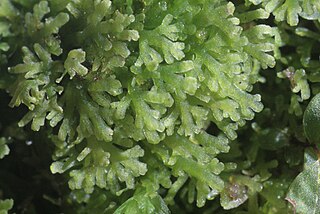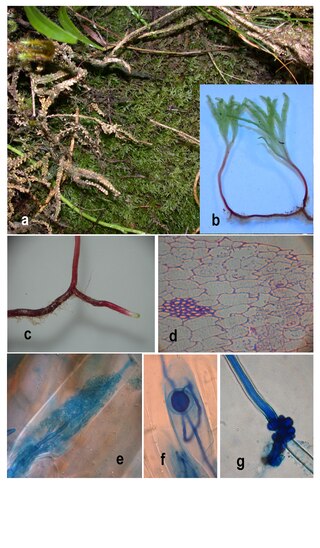
Marchantiopsida is a class of liverworts within the phylum Marchantiophyta. The species in this class are known as complex thalloid liverworts. The species in this class are widely distributed and can be found worldwide.

Jungermanniales is the largest order of liverworts. They are distinctive among the liverworts for having thin leaf-like flaps on either side of the stem. Most other liverworts are thalloid, with no leaves. Due to their dorsiventral organization and scale-like, overlapping leaves, the Jungermanniales are sometimes called "scale-mosses".

Metzgeriales is an order of liverworts. The group is sometimes called the simple thalloid liverworts: "thalloid" because the members lack structures resembling stems or leaves, and "simple" because their tissues are thin and relatively undifferentiated. All species in the order have a small gametophyte stage and a smaller, relatively short-lived, spore-bearing stage. Although these plants are almost entirely restricted to regions with high humidity or readily available moisture, the group as a whole is widely distributed, and occurs on every continent except Antarctica.

Lepidoziaceae is a family of leafy liverworts. It is a group of small plants that are widely distributed.

Porella is a large, common, and widespread genus of liverworts in order Porellales. It is a member of the family Porellaceae within that order.

Pallavicinia is a globally distributed genus in the liverwort family Pallaviciniaceae. thallus is simple contain a strong hair like midrib. thallus area except midrib made out of one layer of cells. thallus is dark green in color and it is very small. thallus is gametophyte. it is the dominant plant. grows in shady and moist environments. thallus is green or pale green in color. 3-6cm in long and 4-5mm broad. margins are entirely or irregularly lobed. most species are distributed in tropical or sub tropical or temperate regions. can be found places like moist soil covered rocks, banks of fresh water streams. female thallus lobes with cup shaped fringed receptacles.
Andrewsianthus is a genus of liverworts in the family Lophoziaceae.
Haesselia is a genus of liverworts in the family Cephaloziaceae. It contains the following species :
Stenorrhipis is a genus of liverwort in the family Cephaloziellaceae.
Colura is a genus of epiphytic type of liverworts and consists of approximately 58-60 species, that are distributed generally in the tropics.

Jensenia is a bryophyte plant genus in the liverwort family Pallaviciniaceae. It has been treated as a subgenus of Pallavicinia by several authors, though a set of features seems to set it apart as a genus. The six or seven species of the genus belong to a southern, possibly Gondwana element.

Pallaviciniales is an order of liverworts.

Pallavicinia lyellii, the ribbonwort or veilwort, is a dioicous bryophyte plant in the liverwort family Pallaviciniaceae. Often seen in moist situations on rocks and soil, with a worldwide distribution.
Kurzia pauciflora is a species of liverwort belonging to the family Lepidoziaceae.

Sphenolobus is a genus of liverworts belonging to the family Anastrophyllaceae.
Gerhildiella is a monotypic genus of liverworts belonging to the family Lophoziaceae. It has only one known species, Gerhildiella rossnerianaGrolle.
Balantiopsidaceae is a family of liverworts belonging to the order Jungermanniales.
Grolleaceae is a monotypic family of liverworts belonging to the order Jungermanniales. The family consists of only one genus, GrolleaR.M.Schust.. It has only one known species Grollea antheliopsisR.M.Schust. from South America.
Clasmatocolea is a genus of liverworts belonging to the family Lophocoleaceae.










